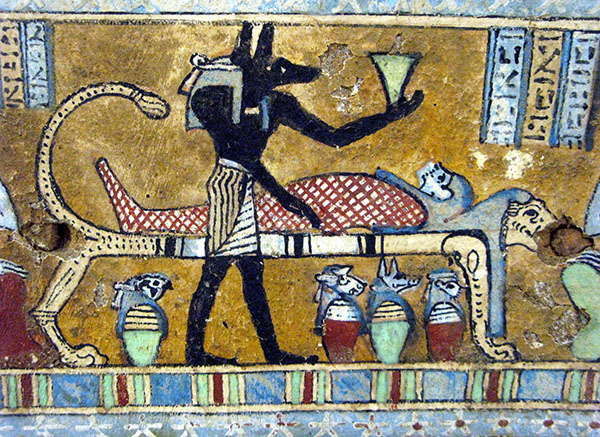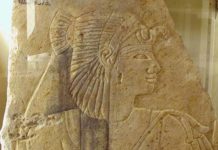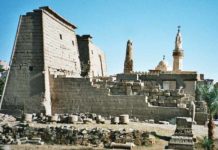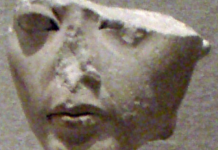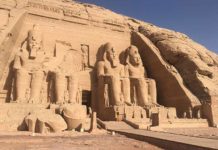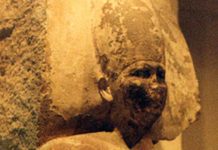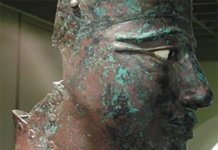The ancient Egyptians invested huge amounts of time, expense and ingenuity in preserving the bodies of their dead. How did mummification develop?
The origin of mummification in ancient Egypt is best viewed as part of a natural development in funerary and religious practice by the ancient Egyptians, traceable from pre-dynastic times. This development essentially involved a gradual separation of the body from the surrounding sand, in order to provide a home for the deceased both here and in the afterlife, and the subsequent introduction of preservation techniques when it became apparent that this was having a detrimental effect on the corpse.
Earliest Egyptian Mummies
Much of our knowledge of the procedure in earlier times is based on inference. There are no ancient Egyptian illustrations of mummification as such. Tomb paintings depict stages in the ritual (such as the Ritual of Opening the Mouth in Theban tombs) and the offerings of prayers, and a few tombs contain scenes depicting the work in the embalming shop, in a rather conventional fashion, such as the Theban tomb of Tjoy from the Nineteenth Dynasty. But there is none of the physical treatment of the body itself, which may have been considered inappropriate subject matter.
Our knowledge is dependent on the physical remains of mummified bodies, supplemented by ancient Egyptians, classical and other references that deal with mummification and that have to be tested against the surviving Egyptian mummies. Herodotus mentions three main processes of embalming, and although the practice was well past its peak by the time he observed it in the fifth century B.C. he remains our best literary reference.
The Ways for Embalming Egyptian Mummies
The first process in getting the dead ready for the afterlife was the most thorough, involving removal of the brain and internal organs, cleaning and rinsing with spices, natron treatment and bandaging with fine linen. Less costly treatment entailed the introduction of cedar oil through the anus with no removal of organs, and the cheapest form was simply to wash out the body with a purge before handing it back to relatives.
All three processes, however, observed adherence to a seventy-day period between death and burial, probably connected with the Sothic Cycle and the Old Kingdom belief that the deceased returned as a star. The poorest ancient Egyptians, who constituted the mass in society, continued to be mummified as they always had been – by the desert sands.
Ancient Egyptians and the Afterlife
The ancient Egyptians believed that various spirits were released at death, the most important being the Ka, the Ba and the Akh, and that the preservation of the physical body in a recognisable form was essential if they were to survive into the afterlife. The physical body of the deceased had to be reunited with the Ba every night, and Chapter 89 of the Book of the Dead recommended that a golden ba bird be placed on the chest of the mummy in order to facilitate this reunion.
Some form of belief in a continued existence after death is indicated from the earliest times in the form of grave goods. Late predynastic times saw the appearance of rough wooden coffins for contracted burials and then wood roofed pits to create an underground chamber in which the coffin was placed along with the grave goods, and the more widespread use of coffins in the early Dynastic period only aggravated the problem with decomposition of the body.
Egyptian Mummies – a Contemporary Craze
By the end of the Middle Kingdom mummification had become something of a national obsession. All kinds of domestic and wild animals were embalmed and buried in immense cemeteries in their millions. Originally reserved for the Pharaoh alone, later obligatory to every citizen, mummification then spread to one chosen animal of its kind and finally to all members of its species.
This would suggest that the ancient Egyptians, supremely satisfied with what they saw as the highest civilisation on earth, strove through mummification to carry everything familiar to them over into the next world en masse, where they could continue in the same way but without the stress (shabti figures started appearing in tombs of the Middle Kingdom to do the menial tasks).
Amulets on the mummy became common in the New Kingdom, the most important being the heart scarab with a flat base on which was engraved Chapter 30 the Chapter of the Heart from the Book of the Dead, a plea to the owner’s heart (which as the seat of character was always left in the body) not to testify against him or her at the Judgement. The udjat, or Eye of Horus, was only marginally less important (frequently used to cover the incision wound), and scarabs, symbols of new life or resurrection, of all kinds were used in great numbers.
Ancient Egyptians and the Final Judgement
Mention of the Judgement reminds us that mummification is not to be viewed in isolation, but as one element in a complex structure of belief which developed slowly over several millennia. This context justifies it, and without it the process would indeed appear bizarre. In fact, every stage was governed by ritual which connected it to the web of mythology.
The mummy itself was identified with the first mummy, which was that of Osiris, and the embalmers adopted the roles of the gods in carrying out their duties in the Wabet and Per nefer structures close to the necropolis, sometimes wearing masks in the appearance of the appropriate divinities.
The Rhind Papyri from Thebes mentions seventeen ceremonies, each connected with a separate part of the body. These documents, incidentally, agree with our other sources over the seventy day period for the completion of the whole process.
Egyptian Mummies as Tickets to the Afterlife
It seems that in mummification, with its rituals and spells and the great care lavished on the deceased, we come closest to the heart of the ancient Egyptians’ outlook, rich and poor alike. They faced death head on, and made the greatest concerted effort of any civilisation to transcend it. In their own minds at least, they succeeded. Which of us can remain unmoved by the quiet assurance of that concluding embalming spell: ’You will live again. You will live for ever. Behold, you are young again for ever’? The ancient Egyptians certainly believed they would be.
Sources:
- Andrews C. 1984. Egyptian Mummies. British Museum Press
- Leca A. 1976. The Cult of the Immortal. Librairie Hachette (Souvenir Press ed., 1979)
- Mahdy C. 1989. Mummies, Myth and Magic in Ancient Egypt. Thames and Hudson
- Murray M. 1951. The Splendour That Was Egypt. Sidwick & Jackson.
- Peck W. H. 1980. Mummies of Egypt. (In Cockburn and Cockburn: Mummies, Disease and Ancient Cultures.) Cambridge University Press.
- Shaw I. & Nicholson P. 1995. British Museum Dictionary of Ancient Egypt. British Museum Press.
- Spencer A. J. 1982. Death in Ancient Egypt. Penguin Books Ltd.


